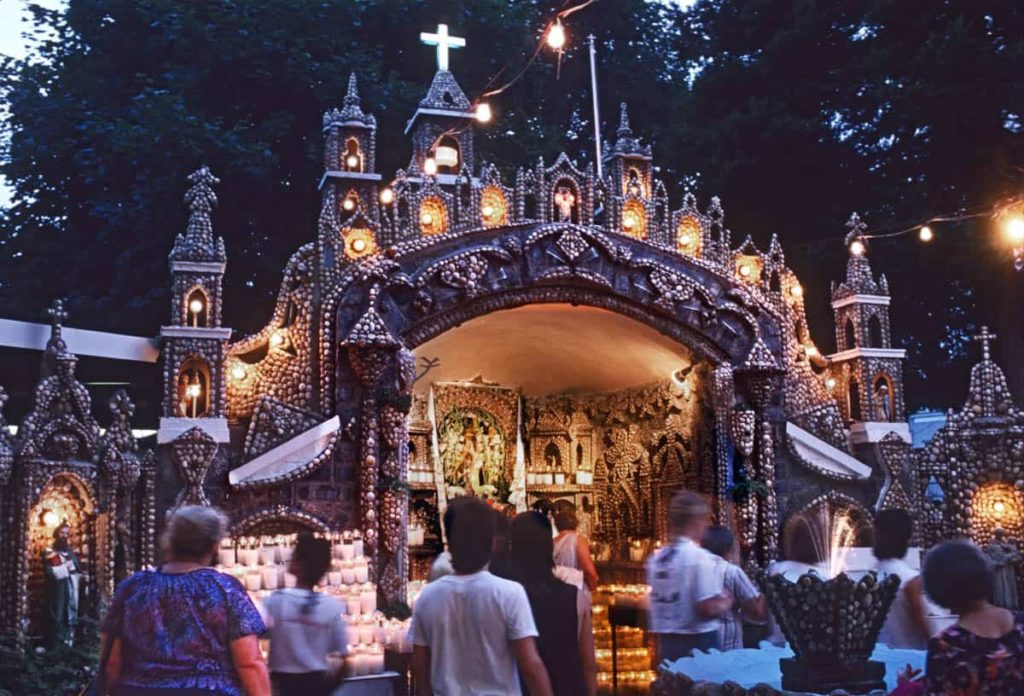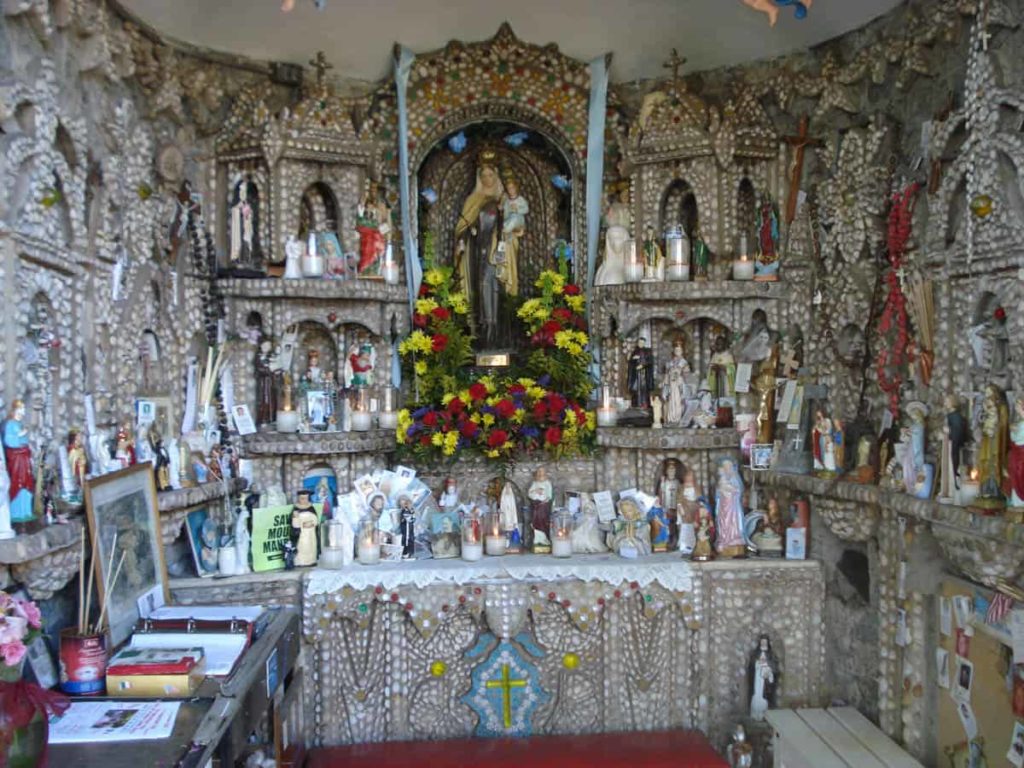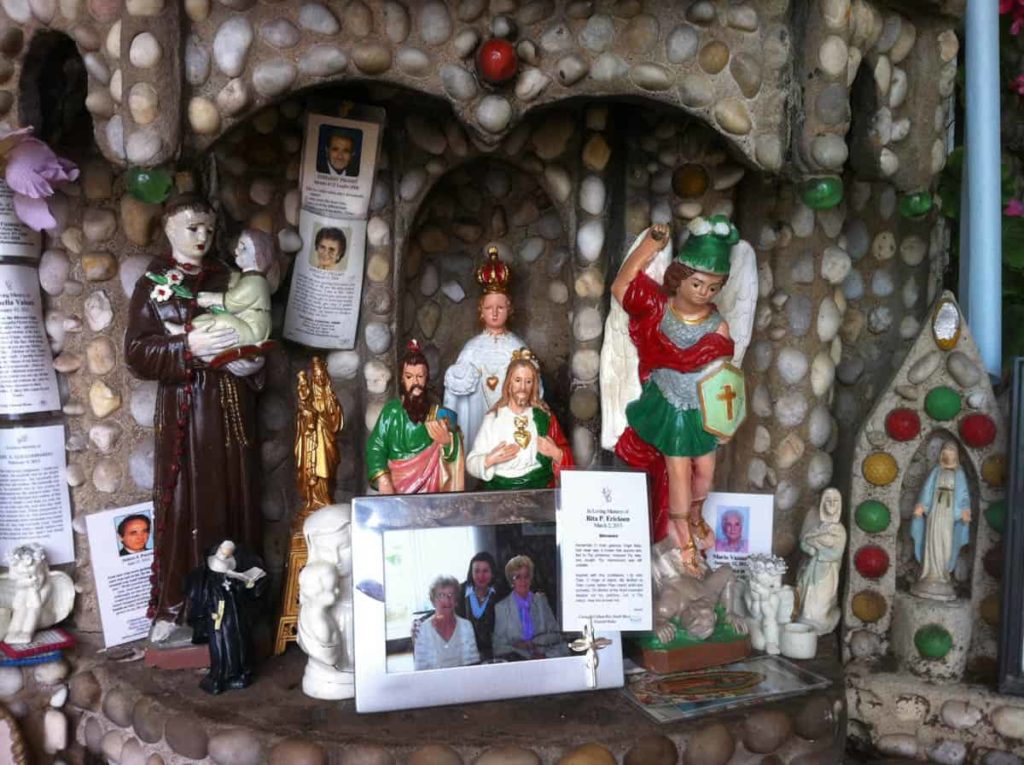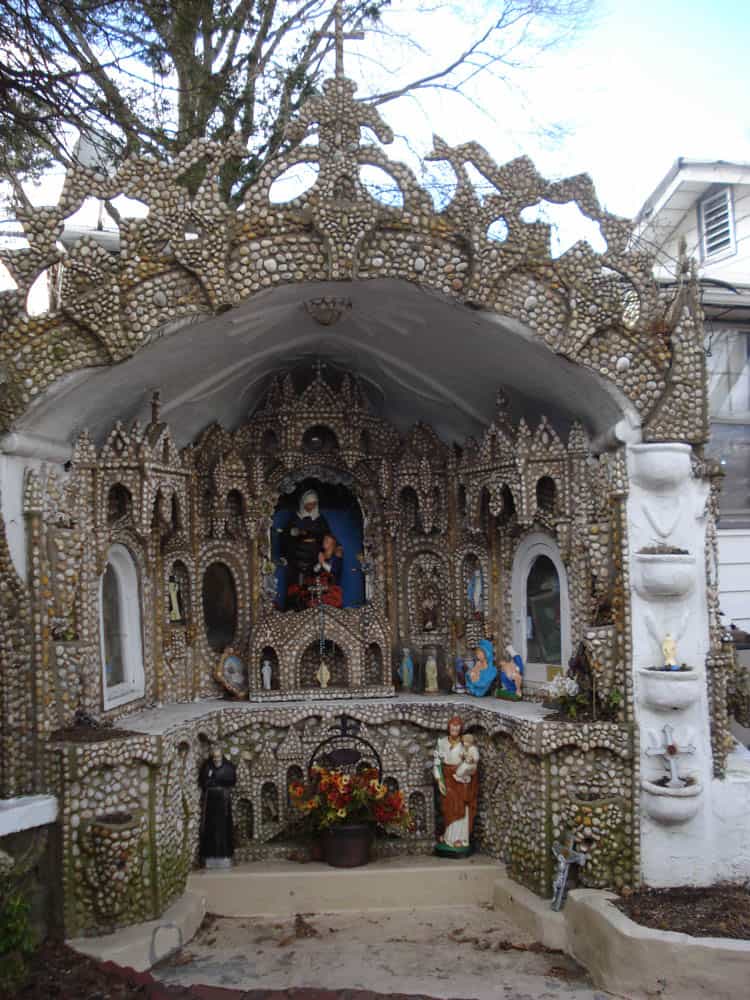We tend to think of practices like votives as the archaic domain of Eastern cultures, such as Hindu temple offerings or Buddhist rituals. But the ritual continues in the West through the influence of the Catholic church, not only in the mixed communities of Latin America but also in the Italian neighbourhoods of New York.
Built with Faith: Italian American Imagination and Catholic Material Culture in New York City by Joseph Sciorra (Queens College) by Joseph Sciorra documents and analyses the relocation of ritual practices from the old world Italy to the new world USA. The extract below tells the story of a unique grotto in New York. The community labour towards this space reflects the festive solidarity of Guendalisaá we see in the Zapotec peoples of Oaxaca.
In the fall of 1937, a group of Italian American men began constructing a grotto, an artificial cave-like structure, in the Rosebank section of Staten Island. As members of the Society of Our Lady of Mount Carmel, they built the structure on property owned by the voluntary association. Today, the lay organization maintains the elaborate shrine and celebrates the Madonna’s July 16 feast with an annual procession through neighborhood streets and activities staged on society grounds. Devotees visit the shrine daily and during the two weekend-long festivities to pray before statues of the Virgin Mary, Jesus, and the saints.
The Rosebank grotto faces the short, dead-end block of Amity Street, a road non-neighborhood residents often find difficult to locate. Then society Treasurer Michael De Cataldo noted, “Either you come looking for this place or you’re not gonna find it” (March 6, 1989). Two signs greet the visitor at the chain-link-fence entrance on Amity Street: a small concrete plaque spelling out “mount carmel” in small stones attached to the fence and a large wood marker heralding the shrine’s 2000 listing on the National and New York State Registers of Historic Places. Trimmed bushes flank a brick path inlaid with a herringbone pattern that leads from the sidewalk to the grotto. On the right of the pathway is the society’s meeting hall, a wood-frame building dating back to the early twentieth century. The side entrance leads to the basement, while the front doorway opens to an upstairs paneled room. Up until the early 2000s, the borough’s Community Board No. 1, the local chapter of the American Legion, and other community groups rented the hall for their regular meetings; private receptions celebrating calendrical festivities and rites of passage are also held there. The back of the hall is rented out as an apartment. At the end of the path are a crucifix and a padded kneeler.
To the left of the path are several religious structures: a vertical wooden shrine listing the names of society members who died in combat during World War II; a shrine to Our Lady of the Immaculate Conception with statues of three kneeling children; a granite–and-bronze tombstone-like memorial to Vito Russo, who is identified as “the founder and builder of the shrine,” flanked by statues of the Sacred Heart of Jesus and the Virgin Mary; a shrine dedicated to Our Lady of Mt. Carmel; and a shrine to St. Anthony of Padua.
The walkway fans out at the end into a small piazza, where a pebble-studded cement fountain sits in front of the grotto. The approximately thirty-foot-high shrine consists of a central chamber built with fieldstones, flanked by two adjoining sections stretching out in serpentine fashion. This central apse contains a linen-draped altar with a padded kneeler and an alcove housing a statue of Our Lady of Mount Carmel holding the Infant Jesus. Candles are available for supplicants near a coin box for donations. Written petitions, family photographs, funeral cards, rosary beads, and other personal and devotional items adorn the altar walls and shelves. A host of religious statues and framed prints can be found throughout the grotto’s alcoves, crevices, and ledges. The walls also contain built-in cement flowerpots where succulents grow. Rising from the grotto is a series of towers and crown-like protrusions, many topped by crosses.
The surfaces of the grotto walls are decorated with smooth round pebbles, as well as glass marbles, shells, translucent plastic flowers, and bicycle reflectors inlaid in cement in various shapes that include crosses, triangles, ovals, stars, and diamonds. (The crucifix and the shrines to St. Anthony and Our Lady of Mt. Carmel along the pathway are decorated in similar fashion.) Springs of curative waters miraculously surging to the earth’s surface accompanying Marian apparitions around the world find their counterpart here in the grotto’s bubbling fountain that operates during the summer. The brilliance of divine light and blinding revelation reverberates in the presence of decorative elements like the glass, plastic, and reflective objects found on the grotto’s surface. An aureole of aluminum foil emanates from oval religious prints set in cement. A multicolored stained-glass lamp- shade crowns an alcove roof containing a statue of St. Anne and the Christ Child. Supplicants visiting during feast time leave an incandescent grove of candles emanating from the central chapel. Electric lights outline, frame, and accentuate the religious statues and architecture, reminiscent of traditional decorative illuminations that arched across city streets and delineated church facades during feste as discussed in the previous chapter.
The southern Italian landscape, especially the area surrounding Naples, is rich in natural caves formed out of volcanic residue and artificial grottos carved from the rocks’ surface. In an account of his journey through southern Italy in the early part of the twentieth century, British traveler Norman Douglas sardonically titled a chapter “Cave-Worship,” to emphasize the importance of grottos in southern Italian Catholicism. The grotto is a pervasive motif in oral and written narratives explaining the origins of popular Italian religious cults: where saints once found sanctuary (St. Roch), where a statue of the Virgin Mary was uncovered by a shepherd (Our Lady of the Snow in Sanza), where the bones of St. Rosalia were miraculously discovered on the outskirts of Palermo, or where St. Michael the Archangel appeared in Manfredonia in 490. Chapels, hermitic cells, and monasteries carved into the rocky sides of mountains and hills going back to the ninth century are found throughout southern Italy. In fact, the region of Campania, in particular the province of Salerno, has a number of caves dedicated to the Archangel Michael, such as the towns Sant’Angelo a Fasanella, Forino, and in Olevano sul Tusciano, to name just three.
After Bernadette Soubirous was canonized in December 1933, there was a proliferation of grotto construction and “replica shrines” on church grounds in the United States, especially in parishes with large Italian congregations. This Catholic propensity for “religious replication” de-localized the sacred and extended its reach far and wide.
The neighborhood
To help themselves meet the challenge of the United States, Rosebank’s Italian immigrants formed mutual-aid societies, which offered such benefits as unemployment and burial insurance. These voluntary associations were responsible for introducing and organizing religious processions and street feasts in honor of the Virgin Mary and patron saints of Italian towns. On Staten Island, immigrants from Contorsi and Auletta, neighboring towns in the province of Salerno in Campania, celebrated two separate feasts in honor of St. Donatus. The Contorsi community in Thompkinsville held their festivities on August 7, and the Rosebank Aulettesi followed with their own celebration ten days later.
Whereas the public adoration of St. Donatus on the island ceased in the late 1950s, the Society of Our Lady of Mount Carmel continues to celebrate its spiritual patroness with a procession and outdoor feast. A weakened paese affiliation was supplanted in Rosebank by a national Italian identity presumably because no one Italian American group predominated in the area. Whatever the reasons, the figure of Our Lady of Mt. Carmel was well-suited to bridging diverging regionalisms because of her popularity throughout southern Italy.
The Society of Our Lady of Mount Carmel of Rosebank, Staten Island, for Mutual Aid was incorporated on February 28, 1903, as a self-help organization open to all Italian Americans, irrespective of their town or regional affiliation. (While membership is now available to any Roman Catholic regardless of his or her ethnicity, the organization remains a predominantly Italian American one.)…
One question I asked repeatedly during my initial interviews was: What was Vito Russo’s reason for building the grotto? This question elicited a variety of answers. The society president at the time, Thomas Chirelli, and Russo’s grandson Vito discussed the immigrant’s motives in this way: Russo: It’s just something he wanted to do, you know. I guess he made a vow to the saint for something. I don’t know what. Chirelli: That was his patron saint and that was it (July 16, 1985). Peter Russo said his father wanted to construct the shrine because he had made a “promise,” or vow that if he was able to come to America and “establish himself, get married,” he would honor Our Lady of Mt. Carmel by “building something” (July 16, 1988). Another son, James, maintained that the grotto was related to the death of Vito’s youngest son, five-year-old Vito Jr., who died in 1935 of pneumonia (March 6, 1989). It is possible that Russo’s creative undertaking complemented and aided the grieving process in a personal “search of structure and order, and the reaffirmation of self” .
What was Russo’s model(s) for his Rosebank creation? Before undertaking the construction of the grotto, Russo had assembled a shrine to Our Lady of Mt. Carmel out of paper, cardboard, and, aluminium foil, and decorated with beads and other baubles in a second-floor room of his Smith Street home. A family photograph of a section of the home shrine reveals distinct ecclesial models, including an altar with a tripartite reredos and tabernacle, along with hexagonal spires and niche canopies, architectural aspects of which would later be found in the grotto. In addition, various decorative and design elements like the diamond shape can be seen in Russo’s domestic shrine and the outdoor grotto. Russo’s eldest son, Michael, was quoted in the Staten Island Advance as saying that his father used photographs of Italian churches to create miniature “cathedrals” in the room. All the family members I spoke to—with the exception of Russo’s eldest daughter, Ida—maintained that the altar was up year round and was not erected temporarily for the July 16 feast day. The shrine’s permanence is evident from one extant photograph. Advance reporter Beth Jackendoff wrote that Russo started building the paper chapel after his son’s death, while James told me the indoor chapel was already up by 1935, and it was the stone grotto that was built in response to the boy’s passing. All those I interviewed agreed that Russo based the grotto on his indoor shrine. Thus the Staten Island shrine must be understood as a composite of grottos and architectural forms worked out by Russo and, as we shall see, fellow society members who collectively engaged in the “disassembling or decomposing existing forms and composing new forms out of the abstracted ideas of bits and pieces of existing forms”…
The construction details were impressive. We know from the May 7, 1938, newspaper account that one hundred sacks of cement were used in the initial masonry work. The fieldstones used in the central chapel were gathered by society members who worked on WPA jobs throughout the city. The brick foundation of the two flanking alcoves and the three towers atop the central apse were made at some undetermined later date. It is said that the pebbles that cover the shrine’s surface were collected by Russo, Chirelli, and other society members who, employed by the sanitation department, would stop along their work routes near the borough’s shores to pick up the stones and carry them back to the society grounds in bushel baskets. Given the sheer number of pebbles used to decorate the various structures, it is quite possible that the smooth quartz stones were obtained from building suppliers or housing contractors in an era before ready-mix cement. The pebble-studded grotto was assembled from sections cast in hand-crafted molds. The stones were pressed into sandbox forms into which cement was poured. When the cement hardened, the wooden frames were dismantled and the stone-encrusted sections were removed and secured in place with cement, wire, and/or metal rods. In the beginning, the stones were applied directly to the grotto’s cement-covered surface. According to Tedesco, the men heard about the new method quite by accident: “Some guy come along, he said, ‘Youse doin’ it the wrong way.’ So he told us, he said, ‘Why don’t youse make a form then put your stones [in]. That’s how.’ We got all our stuff made like that. This guy here who told us, he must be pushing up daisies now'” (July 16, 1985).
Members of the society cast the grotto’s pebble-encrusted pieces in the hall’s basement, the center of social activity for the organization’s male membership. The society hall historically functioned as a male-only social club where members gathered after work free from the responsibilities and restraints of the domestic space, a home away from home where men cooked their own meals without the help or presence of women. The club cellar also served as a private cantina where members collectively pressed their own wine, stored it in barrels, and celebrated the nocturnal communion of the “brotherhood of the grape” with good talk and laughter. A number of men recalled being sent as young boys by their mothers to fetch menfolk who socialized and worked way past midnight. Tedesco’s repertoire of personal narratives pertaining to the grotto included a story about the time Russo and he, drunk, repeatedly broke a grotto section in the course of an evening’s work.

“I get a feeling of peacefulness when I go there”: Imagining the sacred in Rosebank
Neighborhood residents and visitors to the grotto imagine and interpret the architectural structure, its history, and religious import through narrative, texts, and use that invest the site with religious efficacy. Prayer, pilgrimage, and procession are three fundamental ways in which the devout evoke and maintain the grotto’s spiritual power. In addition, individuals attempt to comprehend the grotto and their relationship to it by hypothesizing about the unknown builders, their motives, and artistry, comparing the Rosebank shrine artistically and spiritually to other religious sites, and situating the shrine within shifting temporal and spatial coordinates—for example, past, present, Italy, the United States, the “old neighborhood,” contemporary suburbia.
Bensonhurst resident Lorraine Ghignone was one of the most articulate people I met (in 1988) at the grotto who discussed her thoughts and sentiments regarding the shrine. In an interview at her Brooklyn home, she perspicuously parsed the various components that empower the Rosebank grotto religiously and culturally. We first spoke about how she came to know the shrine, which was a deeply emotional encounter. In July 1987, her mother, Carmela, invited Ghignone to walk in the society’s procession, during which the brass band repeatedly played the Neapolitan song “Mamma”—”a very touching song to Italian people”—which stirred intense and conflated feelings about her mother and the Blessed Mother and made her viewing of the shrine “even more touching to me. It really impressed me. Through my tears I saw the grotto” (August 8, 1988). But it wasn’t the first time that Ghignone had been to the grotto; her parents has brought her there as a young child, when she was around seven years old, but she had no memory of it until that day. “The whole vision of the grotto, not the vision, the actuality, just came back to me and I said, ‘Oh!'” (August 8, 1988). Afterwards, she returned to the shrine whenever she was in the area. When her father, John, became ill in March of 1988, Ghignone visited the grotto each time she accompanied him to his weekly doctor’s appointment. “I’ve been praying that he get better and for me to see improvement in different areas that have been troubling him. And Lord, thanks, I’m seeing a lot of improvements” (August 8, 1988).
At one point during our interview, Ghignone elaborated on the myriad ways she reads the grotto. While her understanding of the subject is uniquely her own, her impressions are echoed by similar expressions of others I have had the opportunity to talk with about the grotto.
Sciorra: Why go there? Why not go to a church? There’s a church right down the block. Why go to this grotto?
Ghignone: Well, let’s see. I do go to churches. So just to let you know, I do go to churches. I go to church here, right around the corner. It’s nice and close. I enjoy that once in a while. I stop at St. Bernadette’s, which has like a grotto-type church but the reason I go to this grotto, maybe partly because it’s Mt. Carmel and it is my mother’s patron saint but I don’t think really that’s the real reason or maybe a small part of the reason but I think the reason I go is because I’m so impressed with the way it’s structured, the way it looks. They also have all, well not all the saints maybe, but an awful large number of the saints in there. That’s part of it too. But it’s a feeling of, I get a feeling of peacefulness when I go there. There aren’t a lot of people around when I go, obviously. You can go anytime you want. And also, I get impressed by the beauty of it. I like the aesthetics. I like beauty in anything and I see a beauty there that I don’t get to see anywhere else. Maybe it’s other places but I haven’t had the advantage of maybe seeing anywhere else. It’s real Old World beauty that just grabs me! You know? My impression of that grotto, the things I get in my mind are [pauses]. Let’s see. To me it’s like, in a way, ornate but a nice ornate not a gaudy or a heavy ornate. It’s ornate in a delicate, perfectly done way. And what’s interesting is there’s no gold, and there’s no platinum, and there’s no fancy, not even wood carvings. Nothing. It’s not really big architecturally. I can’t explain it. It’s no big span. I can’t explain it. But it’s all made in stone and concrete, or cement, whatever. And they took simple stones, simple little stones and plain old concrete but every single one was set in a certain way, into flowers, into patterns, with little archways. Everywhere you see flowers and roses, all out of stones and out of the simplest materials they made something that from a distance it looks like pearls or jewels.
It looks delicate, delicate yet made with these heavy things. [Laughs.] It’s hard to explain. It feels like a very sensitive place. It was done with, I don’t know, but it appears to me that it was done with a lot of sensitivity.
Author
 Brooklyn born and raised Joseph Sciorra, Ph.D., is director of Academic and Cultural Programs at Queens College’s John D. Calandra Italian American Institute. As a folklorist, he has conducted ethnographic research on vernacular expressivity and published on religious practices, material culture, and popular music. In addition to authoring Built with Faith: Italian American Imagination and Catholic Material Culture in New York City (2015), he is the co-editor of the two-volume anthology New Italian Migrations to the United States (2017). He recently completed research on the ephemeral art and impermanent architecture of Italian immigrant Catholic feasts.
Brooklyn born and raised Joseph Sciorra, Ph.D., is director of Academic and Cultural Programs at Queens College’s John D. Calandra Italian American Institute. As a folklorist, he has conducted ethnographic research on vernacular expressivity and published on religious practices, material culture, and popular music. In addition to authoring Built with Faith: Italian American Imagination and Catholic Material Culture in New York City (2015), he is the co-editor of the two-volume anthology New Italian Migrations to the United States (2017). He recently completed research on the ephemeral art and impermanent architecture of Italian immigrant Catholic feasts.






Comments
What an interesting and informative article!
Although I’ve heard of this shrine,
The Grotto to Our Lady of Mt Carmel in Rosebank, SI, I’ve not seen it.
Something I am now looking forward to doing.
Thank you for sharing.